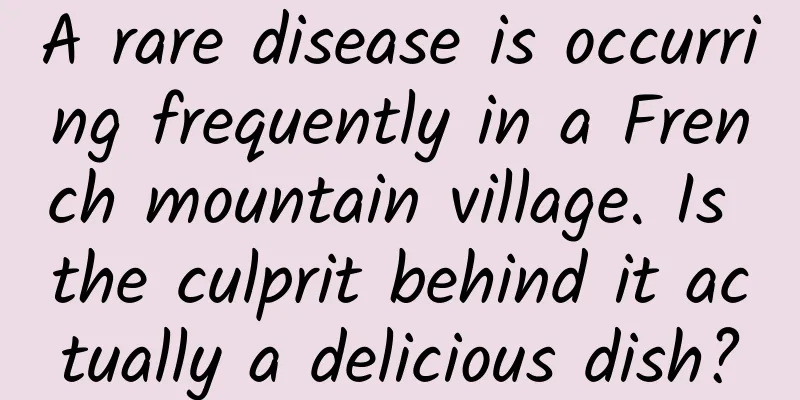A rare disease is occurring frequently in a French mountain village. Is the culprit behind it actually a delicious dish?

|
In Montchaven, a ski resort in the French Alps, a small town with only a few hundred people, a rare disease called ALS is prevalent. After years of research, researchers have found that it is not caused by genetic factors or environmental factors. What is the reason why this rare disease is not rare here? Written by | MaxTom In the French Alps, a winding road slowly climbs to an altitude of 1,200 meters, where lies a small village like a paradise. This once sleepy mountain village developed into a ski resort in the 1970s, and one of the world's largest ski resorts, Paradiski, is here. However, Montchavin has also attracted the attention of medical researchers, but not because of accidents caused by skiing or mountaineering, but because of a rare disease that "frequently occurs" here. Ski resort Montchavin | Photo source: La Plagne 1 The shadow of disease in a small French village One day in 2009, neurologist Emmeline Lagrange welcomed a special patient. She was in her thirties and from Poland. She worked as a ski instructor and cable car ticket inspector during the snow season and worked at the local tourism bureau during the off-season. At this moment, she was suffering from an inexplicable disease, which was diagnosed as amyotrophic lateral sclerosis (ALS), commonly known as "Lou Gestational Sclerosis". This was the fourth case in the village. A neighbor of a local doctor died of ALS 20 years ago, and the doctor had two friends who were still suffering from the disease. Doctor Emily Lagrange | Photo source: chu-grenoble.fr Once upon a time, the "Ice Bucket Challenge" that became popular on social networks made more people aware of this rare disease. ALS is a devastating neurological disease caused by the gradual loss of nerve function in the motor neurons of the brain, spinal cord, limbs, and chest. The discovery of the disease usually begins with muscle twitching and weakness in the arms or legs, difficulty swallowing, or slurred speech. As the disease progresses, patients will gradually feel muscle weakness, and movements that were once easily completed become more and more difficult. Muscles will slowly atrophy, and the body seems to have lost the source of strength. The limbs become stiff, as if gradually frozen by a layer of invisible "ice". Eventually ALS will affect the muscle control required for movement, speaking, eating, and breathing, leading to difficulty breathing and malnutrition, and many people eventually die of respiratory failure. There is currently no cure for this deadly disease, and its exact cause is unknown, though a minority of cases are hereditary. Globally, ALS is both rare and fairly evenly distributed, affecting two to three people in 100,000 people each year. Montchaven is crowded with tourists during the tourist season, but the permanent population is only a few hundred people throughout the year, and the neighboring villages are not large. According to the incidence rate mentioned above, it is very unlikely to find ALS patients here. However, in fact, over the past decade, Lagrange has diagnosed 16 ALS patients in the area one after another. This extremely high incidence rate was completely unexpected by Lagrange, and she recalled that as the number of cases increased, she became more and more scared. Why are there so many ALS patients in this small village? 2 The fog is thick: the road to exploring the cause of the disease In the medical field, ALS has always been a difficult problem to solve. The cause of most ALS patients is unclear, and only 5%-10% of patients can be traced to family inheritance. In most people with hereditary ALS, their children have a 50% chance of inheriting disease-related genes [1]. In addition, medical researchers have found that exposure to cigarette smoke, air pollution and some industrial chemicals is associated with an increased risk of ALS; multiple studies have shown that American veterans are also at a higher risk of ALS than non-veterans, and the reason behind this may be related to the specific military operations they performed during their service (such as exposure to neurotoxins) [2, 3]. However, the exact cause and effect relationship has not yet been determined. Lagrange, Philippe Couratier, a tropical neuroepidemiologist, William Camu, a neurologist, and others formed a team to carefully investigate the cluster of ALS cases in the village of Montchavin [4]. Between 1991 and 2013, five cases of ALS were reported in the village of Montchavin; between 2010 and 2015, seven more cases were found, but not all of them had lived there permanently. Most of the patients had lived in Montchavin for at least ten years. Some were locals who had lived here their entire lives. There were also several seasonal residents who had no geographical connection and came from France, Poland, Turkey, Canada, and the United Kingdom. Even more surprising was that one of them was a couple who both had the disease. The husband was a native of Montchavin. He worked as a ski instructor during the snow season and a lumberjack during the off-season. The wife worked in a restaurant. The husband was diagnosed with ALS in 2005 at the age of 63, and eight years later, the wife was diagnosed with the same disease. However, among these 12 patients, no genetic/familial relationship was found between them. In their blood tests, none of them tested positive for ALS susceptibility genes. This basically ruled out the possibility that the disease was caused by genetics. In order to find the "culprit" of the disease, Lagrange and others decided to start with environmental factors. Like a group of detectives, they did not miss any possible clues: testing for toxic substances in drinking water and garden soil in Montchaven; compounds in snowmaking machines at ski resorts; considering that there is a long-closed lead mine nearby, they also tested the lead content and the level of radon in the patient's home (radon is a radioactive gas emitted from soil and stone). The road to finding the cause is full of ups and downs, and each step is extremely difficult and foggy. However, researchers have never found a single factor that is clearly correlated with all patients. Eight years later, they compiled their findings into a paper, leaving the academic community with a mystery. At the time, the academic community believed that these ALS cases in Montchaven might just be random phenomena. Lagrange said in an interview: "We are stagnant and have no more tricks." 3 Implications of the Cycad Hypothesis Lagrange's research partner, neurologist William Kami, discussed this with ALS scientist Peter Spencer at a 2017 academic conference in Strasbourg, France. “Common contacts were found among the 12 patients: all but one engaged in intensive physical activity, eight had vegetable gardens, six had eaten local mushrooms, five were ski instructors, and four owned a restaurant,” Lagrange and Camu wrote in an abstract of their study presented at the meeting. “I noticed that they reported eating mushrooms among the foods they consumed,” Spencer recalled. “I asked them what kind of mushrooms they were, because one species contained the toxin associated with the Guam cases.” At the end of World War II, American medical researchers discovered in Guam that a rare neurodegenerative disease was prevalent among the local indigenous Chamorro people. Its onset is similar to that of ALS, but it may also show symptoms of Parkinson's disease and dementia at the same time. The locals called it Lytico-bodig disease (the former is ALS, the latter refers to Parkinson's disease and dementia, and some people will show all symptoms at the same time). The disease was very serious in the 1950s and 1970s. According to a report in 1954, the local ALS incidence rate was 100 times the global average [5]. Finally, in 1961, researchers named it Amyotrophic Lateral Sclerosis-Parkinson's Syndrome-Dementia Complex (ALS). The National Institutes of Health opened a research station on the island to investigate the cause. Because of the family connection, the researchers first considered genetic causes, but as in the French mountains, some immigrants also fell ill, so they focused on environmental factors. Among the many hypotheses, the Cycas micronesica hypothesis proposed by nutritional anthropologist Marjorie Whiting in 1963 stood out and became the most supported hypothesis at the time[6]. In the traditional diet of the Chamorro people, there is a unique way of preparing food. They grind cycad seeds into powder and then make it into pasta. Cycads are a plant with a long history and are known as "living fossils". Cycad seeds are the size of plums, starchy, but highly toxic. The wisdom of the Chamorro people is to soak the chopped seeds in water for several days and change the water several times to remove the toxins. However, this treatment method does not necessarily remove all toxins, which sows the seeds of danger. Unfortunately, animal experiments did not verify that cycad seeds can cause ALS-PDC, and the hypothesis was eventually abandoned. Other environmental factors such as metal elements and viruses in the soil were also carefully investigated, but no causal relationship could be established. So far, the road to exploring the cause of ALS-PDC is also full of fog, and the debate continues. Cycad trees (upper left) and cycad seeds (lower left), and their traditional processing by the Moro people. Image credit: PS Spencer /The Canadian Journal of Neurological Sciences, 1987 There is one person who has not given up on the cycad hypothesis, and that is Peter Spencer. In the 1980s, he discovered through monkey experiments that the β-N-methylamino-L-alanine (BMAA) toxin contained in cycad seeds would eventually lead to ALS-PDC. However, the dose of toxin required for his successful experiment was too large and did not conform to the dietary habits of the Chamorro people, so the academic community did not take his discovery seriously. For nearly four decades, Spencer and his colleagues have been committed to studying this issue, and new clues have surfaced. (Of course, there have been many other advances in the past few decades, which will be omitted here.) A study published by Spencer in the journal Frontiers in Neurology in 2019 showed that cycasin, another neurotoxin in cycad seeds, may be related to the onset of ALS. An enzyme in the human body converts cycasin into methylazoxymethanol (MAM), which methylates DNA and induces cell mutations, especially neuronal degeneration. Although the human body also has enzymes that can repair DNA damage, Spencer elaborated on a new view: "Levels of this important DNA repair enzyme in the adult brain are usually low. DNA damage accumulates and activates cell signaling pathways associated with human neurodegenerative diseases." [7] In other words, cycads damage DNA. This is similar to chemical carcinogenesis. The human body also methylates DNA when metabolizing nitrosamines and hydrazine compounds. Accumulation of DNA damage eventually leads to cancer, while neurons do not divide, which may eventually lead to diseases such as ALS-PDC. The similarity in the mechanism of the two has brought new inspiration to related research. So, are the ALS cases in the French mountain village caused by some toxin contained in the mushrooms? 4 The dangers behind tasty mushrooms Lagrange teamed up with Spencer to re-do the survey in the Alps. She found that all the patients had eaten a species of false morel. There are many species of false morels, but the most famous and poisonous is Gyromitra esculenta, which is one of the species that the Montchavin ALS patients collected and ate. This false morel is common in spring forests in Europe, Asia, and North America. The false morel has a unique appearance, with an irregular brain-shaped cap (hence the name "brain mushroom" in China), and a wrinkled surface that is reddish brown, purple brown, golden brown, coffee brown, and other colors. Its edge is basically not connected to the stem, and it looks shaky. The real morel ( Morchella esculenta ) has a conical to blunt cone cap with many pits arranged neatly on the surface, just like a sheep's belly, which is also the origin of its name. Its edge is connected to the stem as a whole, and the structure is relatively stable. Various forms of Morchella esculenta (left) and Gyromitra esculenta (right). Photo credit: Philippe Clowez/mushroom world Both morels and esclents (false morels) are indeed delicious, as evidenced by the fact that both have the specific epithet "esclenta," which means "edible" in Latin, hinting at people's preference for them. Ironically, people have long known that false morels are poisonous, but diners still take the risk and boil or dry them before eating them in the hope of removing the toxin. A study published in June 2024 in the journal Toxicon documented 118 cases of false morel poisoning reported between 2002 and 2020: in 90% of the cases, esclents were the culprit. The most common symptoms of poisoning were vomiting, diarrhea, and stomach pain; a dozen patients also suffered liver damage, one patient had kidney damage, and others reported neurological symptoms such as headaches and dizziness. [8] Different countries have different policies on the sale of fake morels. France and Denmark ban the sale, but Finland allows it. Finns love mushrooms, and they are even printed on stamps. 丨Image source: finnserver.com Through research, Lagrange and his colleagues learned that people with ALS believe that false morels have a "rejuvenating" effect and like the taste of false morels, so they specifically look for them to eat. They all know that France prohibits the sale of false morels, so they form secret small groups to find and eat mushrooms. Sure enough, half of the French ALS patients have experienced acute poisoning after eating false morels. So, is eating false morels a coincidence or is there a real causal relationship? To rule out other environmental factors, the researchers set up a control group and recruited 48 people from the same area who were roughly the same age as the patients and asked them to eat wild mushrooms but not false morels. They ultimately concluded that since no other significant chemical or physical exposures were found, the main risk factor for ALS in the area seemed to be repeated ingestion of these neurotoxic fungi. “This was the key factor that distinguished ALS patients from the control group,” the researchers wrote in their paper.[9] A range of studies have shown that it is not a good idea to consume mushrooms that contain DNA-damaging toxins, and the health effects of excessive intake of potentially neurotoxic metals/metalloids are well established. Plant and mushroom growth naturally bioaccumulates metals/metalloids in soil and water, so that high concentrations of potentially neurotoxic elements can occur in species (both cultivated and wild) used as food.[10] As early as 1968, scientists extracted the main toxin from the gyromitrin, gyromitrin, which is also a carcinogen. In the human body, gyromitrin can be converted into monomethylhydrazine (MMH), which can cross the blood-brain barrier and damage DNA. In fact, this substance can be used as an efficient fuel propellant and has important applications in the aerospace field.
Spencer believes that there must be similarities between the frequent ALS cases in Guam and Monchaweng: the patients all ate natural foods containing toxins, and the toxins are potentially related to hydrazine compounds. Spencer and his colleagues' multiple studies support his view. They have found hydrazine-related chemicals with carcinogenic and neurotoxic potential in certain mushrooms and plants, as well as industrial products in fields such as aerospace. They induce DNA damage (mainly O6-, N7- and 8-oxo-guanine damage), leading to a variety of downstream effects, which are related to cancer and neurological diseases. Unrepaired DNA damage can lead to mutations and uncontrolled mitosis; after mitosis, neurons attempt to re-enter the cell cycle, but apoptosis or non-apoptotic cell death occurs. The role of hydrazine-related chemicals in cancer and neurodegenerative diseases Source: Reference [12] Alden Dirks, a mycologist at the University of Michigan who has studied mushrooms containing gyrosanthes and who identified the false morels eaten by the French patients, and his colleagues wrote in a paper: “There is a growing body of literature raising concerns about the potential for hidden chronic toxicity from gyrosanthesthenes to be associated with neurodegenerative diseases. Further studies are needed to clarify the nature of these associations.”[8] However, some researchers are skeptical of the findings of Lagrange and others. Jeffrey D. Rothstein, a neuroscientist at the Johns Hopkins University School of Medicine, believes that the clustering of cases in Montchaven is a coincidence. He pointed out that there have been reports of clustering of other ALS cases in the past that were later proven to be random. In his view, although the cycad hypothesis makes sense, more research is still needed on the French case. Evelyn Talbott, an environmental epidemiologist at the University of Pittsburgh School of Public Health, finds the neurotoxin theory compelling. “It’s shocking that a husband and wife ate false morels and both developed ALS, because couples with ALS are extremely rare,” she said. The unfinished ending Although the relationship between false morels and ALS has been discovered to some extent, there are still many limitations in current research, and many key issues remain to be resolved. For example, as to the specific molecular mechanism of how the toxin triggers ALS in the human body, simply knowing that false morels contain toxins and that some patients have eaten them is not enough to fully explain the occurrence and development of the disease. Lagrange admits that as a clinical neurologist, she does not have the skills to conduct cell culture, animal modeling and genetic studies that could push the research to new heights, but her colleague Cami has begun testing their hypothesis in laboratory mice. The good news is that no new cases have occurred since Lagrange's investigation, and ALS-PDC cases on Guam have almost disappeared since the 1980s. This seems to point to the culprit as something that shouldn't be eaten. Special Tips 1. Go to the "Featured Column" at the bottom of the menu of the "Fanpu" WeChat public account to read a series of popular science articles on different topics. 2. Fanpu provides a function to search articles by month. Follow the official account and reply with the four-digit year + month, such as "1903", to get the article index for March 2019, and so on. Copyright statement: Personal forwarding is welcome. Any form of media or organization is not allowed to reprint or excerpt without authorization. For reprint authorization, please contact the backstage of the "Fanpu" WeChat public account. |
<<: Look here, how a marine life version of "Game of Thrones" is being staged?
>>: Why do my eyes hurt after wearing my new glasses for a while? I never thought of this reason
Recommend
How to protect coral reefs in today's oceans? - Lessons from corals that built reefs 330 million years ago
Produced by: Science Popularization China Author:...
The 2017 Internet Marketing Vocabulary, a must-have for Internet people! !
This is a major update to the internet marketing ...
7 minefields of big data marketing, how many have you stepped on?
Nowadays, when talking about marketing, if you do...
Historical review: those crazy mobile phone designs ten years ago
[51CTO Translation] With the announcement of the ...
Don’t wear yellow or green clothes when you go out! Otherwise…
Recently, I always encounter some people walking ...
How to leverage information flow for marketing? Use these tricks from Durex!
On Marketing by Leveraging Trends Durex is second...
First look at the project
Open VS2015, create a Web project, select ASP.NET...
Why do my hands peel when the seasons change? It’s not just a lack of vitamins!
Expert of this article: Han Hongyu, Associate Chi...
How much damage will your body suffer if you drink paraquat?
In China, 78% of paraquat users commit suicide. 7...
How to quickly build a marketing and promotion system for B2B products?
In the past two years, the SAAS product market ha...
How to optimize advertising creatives?
“It is as important to have a teacher as it is to...
Use "User Story Map" to split requirements and accurately define product MVP
If you are a startup and haven’t used user story ...
Bidding promotion: What should I do if my bidding account has high costs and low traffic?
Everyone is very familiar with bidding accounts, ...
This time, is VR really close to us?
[[161452]] Human senses are divided into vision, ...
Interesting explanation with pictures and text: What exactly is WeChat Enterprise Account?
Enterprise Account is a mobile application portal...









